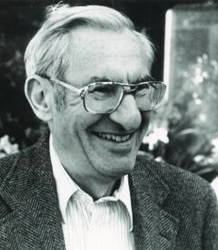

|

|
IN MEMORIAM
Murray H. Protter
Professor of Mathematics, Emeritus
UC Berkeley
1918 – 2008
Murray H. Protter, a longtime professor of mathematics and former chair of the Department of Mathematics at the University of California, Berkeley, died on May 1, 2008, in Berkeley at the age of 90. The cause was congestive heart failure.
Protter was known internationally for his research involving maximum principles and partial differential equations. His work on equations of so-called mixed type was of importance and was also very relevant to the study of transonic flow. Other work of note included the proof of a general uniqueness theorem for a boundary value problem first posed by Francesco Tricomi and work on periodicity problems for pseudo-analytic functions.
In addition, Protter had a great impact on mathematics education and the reputation of Berkeley’s Department of Mathematics. He served with distinction as chair of the department between 1962 and 1965, not long after the 1958 launch of the Sputnik satellite by the Soviet Union. Improved science and mathematics education immediately became a national priority to maintain U.S. competitiveness, and Protter helped hire many of the great mathematicians of the day, turning UC Berkeley into one of the best mathematics departments in the U.S. and the world.
Murray was born February 13, 1918, and grew up in Brooklyn, New York. He graduated from the University of Michigan in 1937 at the age of 19 and earned his Ph.D. at Brown University in 1946. It was at Brown that he met his wife, Ruth Rotman Protter (who died November 20, 2008). Their first child, Barbara (now Barbara Protter Robison of Kansas City), was born in Providence, and then they moved to Syracuse, where their son, Philip (now a professor of operations research at Cornell University), was born. Murray leaves four grandchildren and three great-grandchildren.
After the U.S. entered World War II, Protter interrupted his studies toward the doctoral degree and joined the war effort as a physicist in Washington, D.C., and then, from 1943 to 1945, at the Vought Aircraft Company in Stratford, Connecticut, a major manufacturer of military aircraft. At the latter, he calculated the flutter speeds of military aircraft, that is, the speed at which an airplane’s wings begin to vibrate violently—sometimes so violently that they fall off. At the time, this was a recurring problem in airplane design. Protter’s calculations allowed the company to make the flutter speed faster than the airplane was designed to fly.
After a postdoctoral year at Brown University, Protter was recruited in 1947 to Syracuse University, which at the time was building a very strong mathematics department. But this department soon faltered and suffered a number of resignations, including that of Protter in 1951. He then moved to the Institute for Advanced Study in Princeton and remained there until 1953, when he joined the UC Berkeley faculty.
Protter was the author of many books. The most famous one, Calculus with Analytic Geometry: A First Course, was written jointly with C. B. Morrey Jr. and published in 1964. It became the second best-selling calculus text in the U.S. and sold over a million copies. The research book of which he was most proud was Maximum Principles in Differential Equations, written jointly with Hans Weinberger, first published in 1967, and reissued by Springer Verlag in 1999.
One of Protter’s innovations at Berkeley was self-paced learning, which he started in the Department of Mathematics in 1972 to allow students to advance in calculus at their own pace through independent study. Students were enthusiastic about this form of instruction, with enrollment jumping from an initial 85 students to 500 students two years later. Self-paced calculus lasted some 20 years, with one-third of all calculus students taking it at one point.
While at Berkeley, Protter was chosen to lead a delegation of mathematicians to the Soviet Union as part of a cultural exchange during that nation’s brief period of liberalization.
Protter’s expertise was also sought by industry. Shell Oil Company consulted him about their failure to find oil where their seismic surveys and mathematical equations had predicted it would be found. Protter pointed out that they were using wave equation type partial differential equations with boundary conditions that had no solution, and provided the correct formulation of the problem.
Protter was active in the American Mathematical Society, serving for many years as its associate treasurer, and also as a longtime editor of book reviews for the Bulletin of the American Mathematical Society.
Murray retired in 1988, when he received UC Berkeley’s highest honor, the Berkeley Citation. He was recalled from retirement between 1990 and 1992 when Alberto Grunbaum agreed to take over as chair of the Department of Mathematics, but only if Protter would agree to serve as deputy chairman.
His junior colleagues remember with great fondness Murray’s kind and generous advice, and the many lively dinner parties hosted by Murray and his vivacious and gracious wife Ruth. The department has lost a distinguished scholar and a man of great integrity and sound judgment, and we all have lost a great and trusted friend.
Calvin Moore
Alberto Grunbaum
Ole Hald
Keith Miller